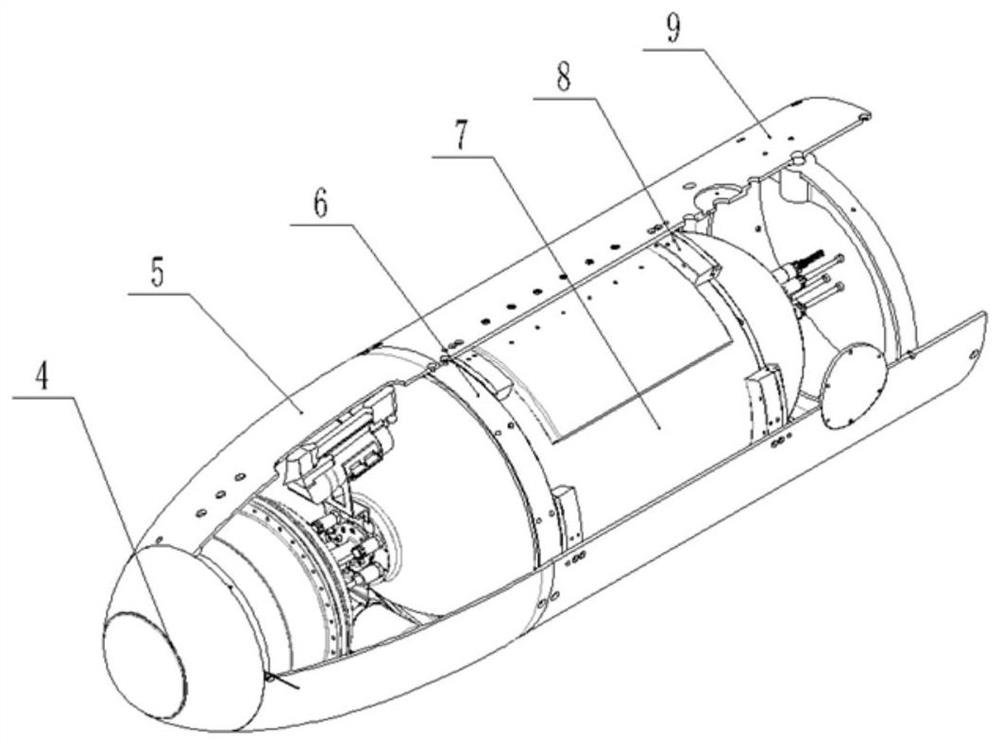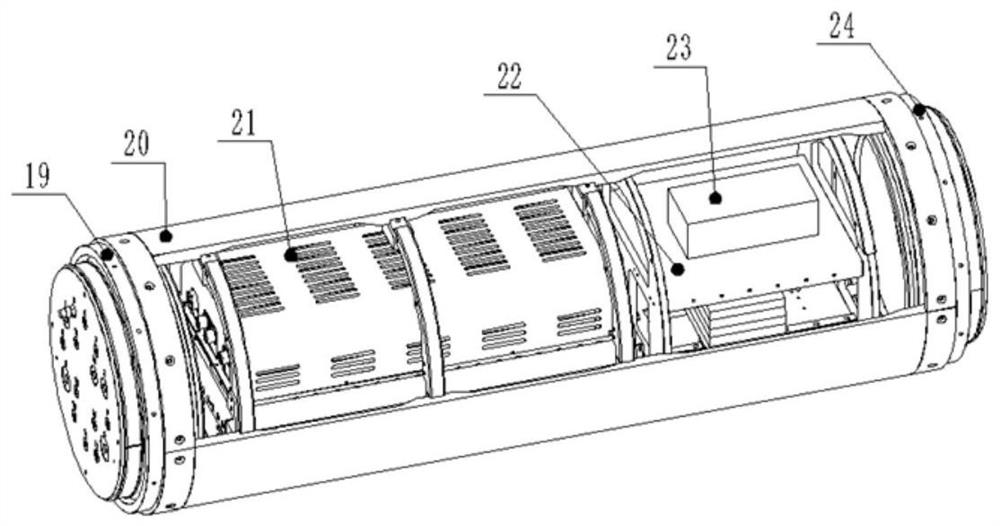A large underwater vehicle with self-destructing wings
A technology for underwater vehicles and wings, which can be applied to underwater ships, underwater operating equipment, motor vehicles, etc. It can solve the problems of weakened maneuverability of the whole machine, increased quality of accessories, difficulty in ensuring high-precision fixed-depth navigation, etc.
- Summary
- Abstract
- Description
- Claims
- Application Information
AI Technical Summary
Problems solved by technology
Method used
Image
Examples
Embodiment 1
[0024] Embodiment 1: A kind of large-scale underwater vehicle that possesses self-abandoning type wing provided by the present invention, its overall appearance is as follows figure 1 As shown, it includes bow assembly 1, middle assembly 2, tail assembly 3 and wing unit 12; see figure 2 , the bow assembly 1 includes a cable throwing module 4, a bow shell 5, a bow connecting ring 6, a front buoyancy adjustment module 7, a front connection fixing block 8, and a front glass fiber reinforced plastic shell 9; the cable throwing module 4 and the bow shell 5 The front end is fixedly connected by eight circumferential bolts; the bow shell 5 and the front glass fiber reinforced plastic shell 9 are connected by the bow connecting ring 6, and the connection method is fixedly connected by ten bolts evenly distributed in the circumferential direction; the front connecting fixed block 8 has eight one, and have a through hole, between the front glass fiber reinforced plastic shell 9, the fr...
Embodiment 2
[0030] Embodiment 2: The dual-buoyancy hybrid large-scale heavy-duty underwater vehicle provided by Embodiment 1 is used to carry out underwater gliding detection navigation without propulsion, and the propeller is always closed.
[0031] The process of diving is: before the diving process, the underwater vehicle floats on the water surface in a state of neutral buoyancy. After the diving mode is turned on, the control module 23 sends a signal to control the attitude adjustment module 22 to adjust the attitude, and then controls the front and rear buoyancy adjustment modules. 7, 13 reduce the overall buoyancy of the underwater vehicle, thereby realizing the dive. During the dive, the sensor carried by the control module 23 controls the signal measurement and saves, and at the same time controls the attitude adjustment module 22 and the cross rudder 17 to ensure the gliding attitude and course;
[0032] The process of floating is: when the underwater vehicle dives to the target...
Embodiment 3
[0036] Embodiment 3: The dual-buoyancy hybrid large-scale heavy-duty underwater vehicle provided by Embodiment 1 is used to carry out underwater propulsion and depth-fixed exploration navigation.
[0037] Dive to the target depth process: after the dive mode is turned on, the control module 23 sends a signal to control the attitude adjustment module 22 to adjust the attitude, and then controls the front and rear buoyancy adjustment modules 7 and 13 to reduce the overall buoyancy of the underwater vehicle, thereby realizing the dive;
[0038] Depth-fixed detection cruising process: After diving to the target depth, the control module 23 controls the mounted sensor to measure and save the signal, and at the same time controls the attitude adjustment module 22 and the cross rudder 17 to ensure the gliding attitude and heading, so that the underwater vehicle is always at the target Depth range, in level sailing state;
[0039] Floating process: When the depth-fixed detection cruis...
PUM
 Login to View More
Login to View More Abstract
Description
Claims
Application Information
 Login to View More
Login to View More - R&D
- Intellectual Property
- Life Sciences
- Materials
- Tech Scout
- Unparalleled Data Quality
- Higher Quality Content
- 60% Fewer Hallucinations
Browse by: Latest US Patents, China's latest patents, Technical Efficacy Thesaurus, Application Domain, Technology Topic, Popular Technical Reports.
© 2025 PatSnap. All rights reserved.Legal|Privacy policy|Modern Slavery Act Transparency Statement|Sitemap|About US| Contact US: help@patsnap.com



